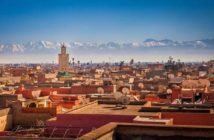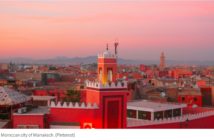Fès and the surrounding areas in North-Central Morocco offer a variety of cultural and historical treasures to explore. Likely lead The fertile countryside beyond Volubilis. (Michael Varga)
I was surprised to learn that one of the best-preserved and most extensive Roman sites in the world resides in North-Central Morocco.
Following two weeks of traveling through Morocco’s Imperial cities, labyrinthine medinas, vast, dry deserts, and fashionable coastal towns, the highlight was definitely Volubilis—Morocco’s most important archaeological treasure.
A chance encounter onboard a train headed for Fès led me there.
“Make sure to purchase first-class tickets,” the proprietor of our bed & breakfast in Casablanca advised. Michael, my traveling companion, and I nodded. At the ticket counter, I had an impetuous change of heart and surprised us both when I blurted to the cashier, “Two second class tickets to Fès, please.” Michael glanced at me, puzzled.
“It’ll be more interesting,” I promised.
We found a pair of seats in a car packed with jovial, chatty locals, eager to advise us on our itinerary. Drissia Ras, a self-assured, friendly twenty-something environmental scientist, quickly befriended us. Most Moroccans we met were fluent in French and Arabic, though Drissia spoke English effortlessly as well. That’s because she had recently spent 18 months working for a non-profit environmental organization in Seattle.
Bab Boujeloud, one of four main gateways leading to the old town of Fès El-Bali. (Michael Varga)
We had originally planned to spend all three days roaming in the heart of Morocco’s oldest neighborhood, Fès El-Bali. Over 1,200 years old, its 9,665 tight, wiggly lanes are barely wide enough for two people to stroll side-by-side. This living museum contains 13th–14th century mosques and palaces, one of the oldest universities in the world, and a milieu of bazaars, craft shops, and food stands.
Despite the treasures to be experienced in Fès El-Bali, Drissia encouraged us to venture out and see the countryside. I gazed outside our train window at the rolling hills and fertile farmland. A daylong side trip to break up the intensity of Fès didn’t sound like a bad idea at all. When Drissia offered to accompany us there, a mere 40 miles outside of Fès, the plan was sealed.
The next morning, we met up with Drissia and her sister Hajar, and hired a taxi for the day. The fertile, undulating landscape—abundant with silvery olive trees and rows of jagged prickly pear cactus—reminded me of Tuscany. We drove by miles of fava bean and onion plant farms, and acres of orange groves. The tree limbs curved and sagged from the weight of bright, plentiful fruit.
The remaining walls and columns of the Basilica of Volubilis, built around 217 A.D. (Michael Varga)
Around the year 40 A.D., the Roman Empire annexed this remote outpost specifically for this rich, fecund Moroccan plain. It replaced acres of indigenous forests with large-scale agriculture and exported all that was reaped back to Rome.
At its height, Volubilis housed as many as 20,000 residents, who were exempt from Roman taxes, because they lived so far from the mother ship. Rome abandoned Volubilis around 280 A.D., though its footprint penetrated so deeply that Latin continued to be spoken here up to the arrival of Islam in the 8th century.
We wandered around the site for the better part of a bright, chilly February morning, imagining the city that once filled the space between the remaining stones. Archaeologists marvel at the sophisticated sewage system the Romans engineered. Walking along the eight perfectly formed arches of the grand basilica felt like traveling back in time. Then we noticed that the tops of tall, reconstructed columns now function as comfortable habitats for storks to nest.
A detail from a marble mosaic floor in the House of the Acrobat, depicting an athlete receiving a trophy for a horse riding competition. (Giannella M. Garrett)
Astonishingly preserved mosaic floors, said to be among the finest in existence, offer insight into the stately homes the Romans built. In 1997, Volubilis was declared a United Nations Educational, Scientific, and Cultural Organization (UNESCO) World Heritage Site, and continues to be an excavation in progress. A museum, displaying the plethora of treasures discovered here, will open later this year.
If the remains of Volubilis represent homage to the Roman civilization that disappeared, Moulay Idriss illustrates the Islamic culture that stayed. Our taxi driver transported us to the holiest town in Morocco, about a three-and-a-half mile drive from Volubilis, by way of a scenic mountain back road. We stopped to ogle its twin hillsides, Khiber and Tasga, cradled in the surrounding verdant mountains. Drissia pointed out how they resemble a double humped-back camel.
Hajar (L) and Drissia overlooking Moulay Idriss. (Giannella M. Garrett)
A delightful jumble of whitewashed homes and mosques, the town is named after its founder and Morocco’s most revered saint, Moulay Idriss el Akhbar. The great grandson of the Prophet Mohammed, Idriss fled persecution in Mecca and settled here at the end of the 8th century. He created the Idrisid Dynasty, appointed himself Morocco’s first king, and converted the locals to Islam. Every August the country’s largest pilgrimage, or “moussem,” arrives to honor his tomb. Up until 1912, this sacred town was closed to non-Muslims, and it was not until after 2005 that non-Muslims stayed overnight.
Foreigners are now warmly welcomed. Drissia and Hajar giggled like school children as we drove past a house at the town’s entrance. Their family had lived there for three years when they were growing up. Our taxi driver deposited us at the top of Khiber Hill. We ambled down a flight of steep steps, stopping off at various landings to enjoy the panorama.
Our route emptied us into the main square, Place Mohamed VI. There we relaxed in an outdoor café and absorbed the animated street life. It felt like the set of a film. Men strolled by in bright, flowing djellabas (an outerwear robe donned by many locals), while smoky tajines sizzled in food stalls, and a procession of donkeys chugged along, braying under the weight of their daily loads. Drissia treated us to sticky, glutinous halwa, a popular local snack that brings to mind peanut brittle.
The Bab el-Mansour in Meknès is the grandest of all Imperial Moroccan gateways. It was completed in 1732 by Moulay Ismail’s son, Moulay Abdallah. (Giannella M. Garrett)
We found our driver parked on the square, chatting with the villagers. He drove us back to Meknès where Drissia and her sister live. We devoured a late lunch feast on the sunny rooftop terrace of Restaurant Salma. Although Salma is famous for its pigeon pie, we instead opted for grilled vegetables and a refreshing tomato and cucumber salad. Salma’s wrought-iron railing, tables, and chairs and blue terra cotta tiling offered a cozy perch from where we could enjoy the starting point for a walking tour through the old city.
Sultan Moulay Ismail was revered as the ruler who unified and came to power in 1672. He made Meknès the capital during his 55-year reign. The unprecedented scale of construction he oversaw—lavish palaces, beautiful mosques, monumental squares, miles of ramparts, gates, and doors— offset his cruel, brutal monarchy. Meknès transformed into such an exquisite imperial city; it was referred to as the “Versailles of Morocco,” a reference to the comparably extravagant palace built by King Louis XIV of France.
From our dining table, we ogled the pavilion, where the sultan is said to have received ambassadors from around the world. Beneath it lies miles of underground cells, which allegedly housed prisoners who constructed the city. Around the corner stands the Mausoleum of Moulay Ismail, who died in 1727.
Shopping for a Moroccan rug in Meknès. (Giannella M. Garrett)
Re-energized, we sauntered over to Place el-Hedim, the lively square at the heart of the Meknès medina. From there, we admired the ornate and mesmerizing grand imperial gateway, Bab el-Mansour. A UNESCO World Heritage site since 1996, Meknès enjoys the distinction of being the smallest of the four Moroccan Imperial cities, after Rabat, Marrakesh, and Fès.
We strolled around the suks (markets) and alongside the ramparts. Michael bought a small Moroccan carpet that was priced much more reasonably than a similar one we had seen in Fès the evening before.
With barely enough energy left to tumble into the next train back to Fès, just a 45-minute train trip away, we bid adieu to Drissia and Hajar and thanked them for one of our most memorable days in Morocco.
.













